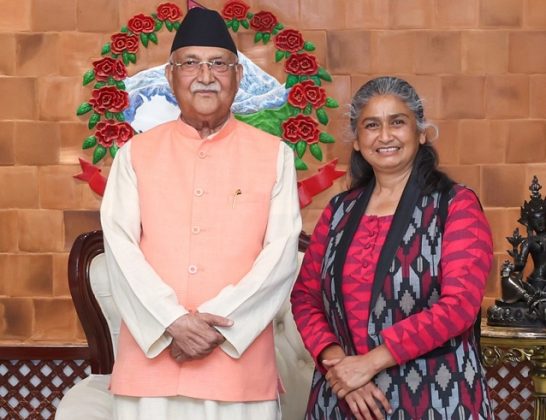Reviving Nepal’s Film Industry Still A Challenge
Kathmandu, Jan. 2: Nepali film industry has been one of the hardest-hit sectors by the COVID-19 pandemic. While all other sectors have almost returned to normalcy, the film industry is still struggling to resume business as usual.
Ironically, the local theatres attract crowds of audience when they release Bolywood and Hollywood movies, but remain deserted when they release a Nepali film. It is evident from the failure of Churifuri, a Nepali film by Rishi Raj Acharya, and the crowds of audience to watch Indian movies Suryabanshi and Pushpa in local theatres.
In a period of 21 months, from March 2020 to now, only four Nepali films—Euta Yesto Prem Kahani, Dandako Bar Pipal, Churifuri and Kathputali — were released in halls but unfortunately, three of the movies completely failed to lure audiences to the halls. Only Veemsen Lama’s Kathputali showed an encouraging sign on the first day of its release on Friday.
However, Bollywood film Suryavanshi, South Indian film Pushpa and Hollywood film Spider-Man: No Way Home became box-office success in Kathmandu, clearly suggesting that Nepali films are not in harmony with the need of the audience.
Churifuri and Dandako Bar Pipal were released looking at the high turnover of audience to watch Suryabanshi and Pushpa. But they ended becoming super flops. Besides the poor quality of Nepali films, there are other problems associated with them.
Financial crunch
Veteran actor Nir Shah admits this fact. He says that Nepal’s film industry is in a state of extreme financial crisis and only a sustainable supply of capital can help revive it.
Due to the pandemic, not only the cinema sector but also the overall economic system lost its balance, so there is a need to move with a new vision, Shah told The Rising Nepal. “If investors do not invest, production of films will fall and without production, the film industry cannot be revived,” he said.
When filmmaking declines, many of the factors associated contribute to slow down of the sector, making the film industry less enthusiastic. Failure to prioritise alternative digital platforms and mini-cinema halls could lead to a collapse of the cinema sector, he expressed his worry.
“Our cinema sector has become extremely urban-oriented and had cinema been given a rural touch, it would have been easier for it to return to normalcy. But, as the new structure of development moves forward, the movie sector will find its own way. Thus, the concerned bodies should not delay to make a better plan accordingly for the revival of the ailing film industry,” said Shah.
Arguing that the government’s support is essential to revive the film industry, Shah suggested three remedies to overcome the current problems facing the industry. They are: The government should create a financial institution to run the cinema sector, build a strong digital platform (OTT) under this financial institution and set up mini-cinema theatres in the rural areas.
Until the COVID-19 hit the country in March 2020, around Rs. 2 billion used to be invested in films annually.
According to Akash Adhikari, President of Film Producers’ Association Nepal, around Rs. 2 billion was invested in cinema in 2018 when a total of 110 films were produced. Of them, 85 to 90 films were released in the theatres.
“Among them 5 to 10 per cent films succeeded to make profit, 15 to 20 per cent films managed to recover their investment and almost 75 per cent films lost their investment,” said Adhikari.
After the government imposed lockdown in March 2020, a total of 35 films readied to be released, 22 in post-production phase and 82 whose shooting had begun were directly affected.
According to a report of the entertainment forum under FNCCI, investment of around Rs. 1.75 billion was frozen in those 139 films. Even during the pandemic, about 25 films have taken permission for the production and only 10 of them were shot, said Adhikari.
With the closure of cinemas, thousands of people have lost their jobs. According to Adhikari, around 35,000 people are directly involved in the film industry and a further 175,000 people are indirectly dependent on it. About 50 per cent people involved in the film industry also earned from the music industry.
Because of the pandemic, a total of around 150 halls across the country had to be shut down and of them 30 to 35 single theatres have permanently shut their doors, said Adhiakri.
Poor quality to blame
Veteran film director Tulsi Ghimire says the industry could be revived only by making good films which can attract the audience to halls. Only better films can revitlise the industry, but making a good movie requires financial support, he said.
“Audiences are eager to watch Nepali movies, but they are disappointed as Nepali movies do not meet their taste,” Ghimire added. “But now I have seen some filmmakers coming up with strong content and I am positive that the film industry will glitter again.”
According to Raksha Singh Rana, film director and President of Film Directors Guild of Nepal, the pandemic has pushed the Nepali film industry five years behind.
She thinks bringing audience to the hall to watch Nepali films is the main problem for the revival of the Nepali film industry. “Again, Nepali artistes are devaluing themselves. Normally, viewers also come to see the movie to glimpse the artistes, but over exposure of Nepali artistes on TikTok and social media, has killed the curiosity of the audience,” she added.
According to Arjun Kumar Khadka, producer of Chapali Height-3, it has become clear from the success of Bollywood and Hollywood movies in local theatres that audiences come to the hall to watch quality movies.
He is releasing his Chapali Height-3in theaters on January 14 even though he knows well that no Nepali film released after the pandemic survived in theaters.
“Since the audience liked the two sequels of my movies Chapali Height, I am confident that the audience will come to see my movie Chapali Height-3,” he said.
Expressing his frustration, he said if the story of Nepali film is good, the audience will like the film, but the irony is that in the Nepali film industry, there is a greater tendency to pull someone’s feet than to cooperate with each other.
Investment fund in offing
Film Development Board (FDB) chairman Dayaram Dahal said that FDB is providing assistance for VPC (Virtual Printing Cost), encoding, publishing, printing, and promotion of the films which are ready for their release.
He informed that FDB had also arranged a ‘special assistance package’ for the films which were being prepared for release in March, April, May, and June of 2020, but the package was stalled due to the pandemic.
Nepali Film Association, Film Producers Association and Film Development Board have made rules of not showing multiple Nepali films at the same time for some time, he added.
The FDB has also implemented ‘Project Insurance’ to cover the risks and to encourage filmmakers to filmmaking, he added.
FDB also plans to set up a film investment fund and conduct in-depth research on film production, release, distribution, the status of Nepali films, direction, management, and media publicity, said Dahal. FDB has also adopted the concept of story bank with the aim to develop, promote and preserve indigenous films as well as to promote original, historical, artistic, social, cultural and informative films and films based on national identity.













Comments